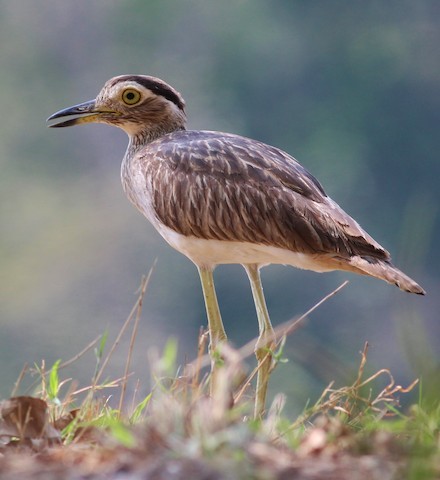Burhinidae: Thick-knees

Double-striped Thick-knee. © Tom Benson
The thick-knees are a small group of large shorebirds that typically inhabit tropical savannas, grasslands, and rocky plains—hence their alternative name stone-curlew—although three species are primarily associated with waterbodies. Most are at least partly nocturnal, spending the daylight hours hiding quietly in the shade of rocks and bushes. At night they become active and loud, giving piercing calls that carry for up to a mile or so.
Thick-knees have the general appearance of oversized plovers, with long legs, robust bills, and large eyes. Their knees are on the thick side, but not impressively so. The eight species in the genus Burhinus are cryptically plumaged and despite their size are surprisingly adept at blending into the landscape. The remaining two species, usually assigned to a second genus Esacus, have boldly marked heads, shorter legs, and much heavier bills.
Eurasian Stone-Curlew (Burhinus oedicnemus)
Indian Stone-Curlew (Burhinus indicus)
Senegal Thick-knee (Burhinus senegalensis)
Water Thick-knee (Burhinus vermiculatus)
Spotted Thick-knee (Burhinus capensis)
Double-striped Thick-knee (Burhinus bistriatus)
Peruvian Thick-knee (Burhinus superciliaris)
Bush Thick-knee (Burhinus grallarius)
Great Thick-knee (Esacus recurvirostris)
Beach Thick-knee (Esacus magnirostris)
References
Marchant, J., T. Prater, and P. Hayman. 1986. Shorebirds: An Identification Guide to the Waders of the World. Houghton Mifflin, Boston.
Roberson, D. 2003. Bird Families of the World: Thick-knees, Burhinidae, http://creagrus.home.montereybay.com/thick-knees.html. (Posted December 8, 2003; Accessed September 21, 2019.)